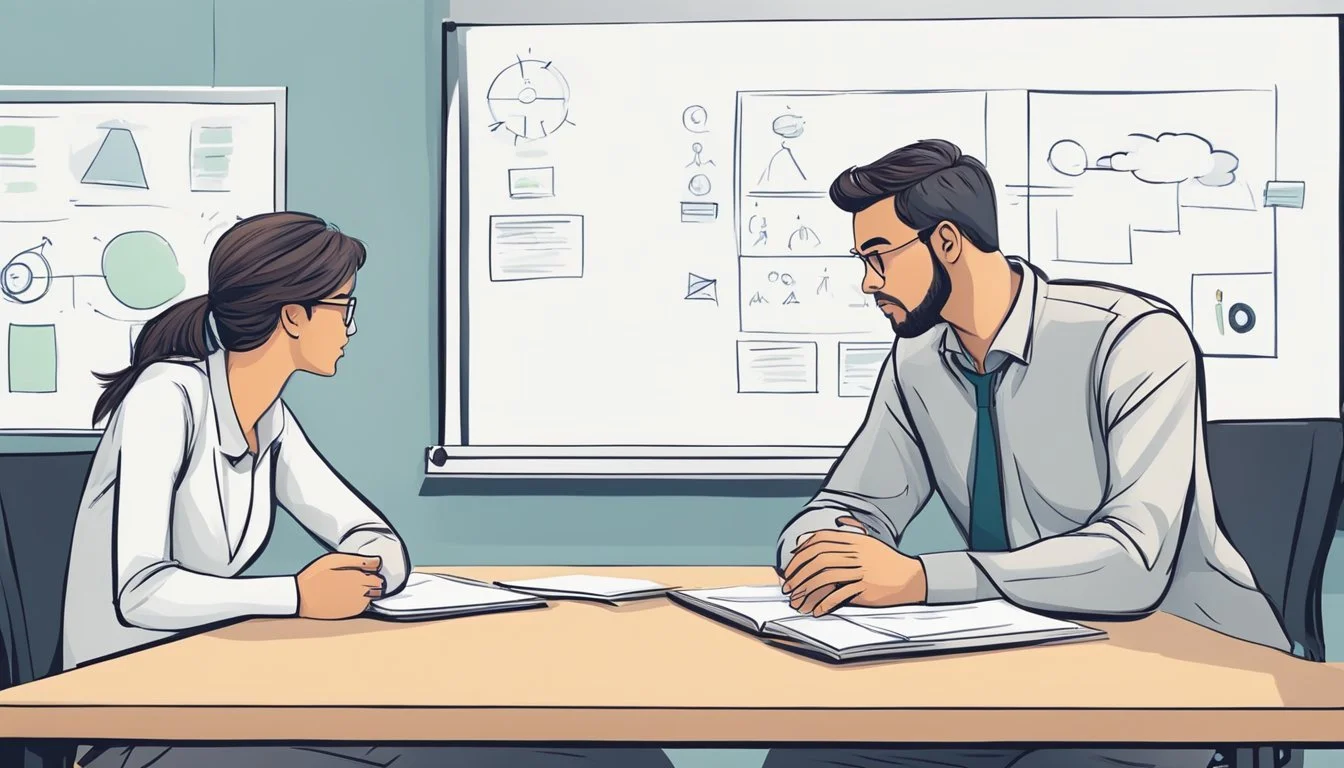15 Signs Your Partner is Committed to Resolving Conflicts Constructively
Key Indicators for a Healthy Relationship
Conflict resolution is a crucial aspect of any healthy relationship. When partners are committed to resolving issues constructively, it fosters a stronger bond and greater mutual respect. Recognizing the signs of this commitment can be instrumental in understanding the health and potential longevity of the relationship.
How can you tell if your partner is genuinely dedicated to resolving conflicts constructively? This article explores 15 key indicators that demonstrate a partner's commitment to maintaining harmony and understanding within the relationship. Identifying these signs can provide reassurance and promote a more collaborative approach to handling disagreements.
1) Active Listening
Active listening is a crucial sign that a partner is committed to resolving conflicts constructively. This technique involves fully concentrating on, understanding, and responding to the other person during a conversation. It emphasizes empathy and creates a safe space for open communication.
A partner who practices active listening will often suspend their own judgment, allowing their partner to express feelings and concerns without interruption. This approach helps in revealing the true needs and emotions behind the conflict.
Active listening techniques include paraphrasing what the other person has said to ensure clarity and asking open-ended questions to encourage further discussion. Maintaining eye contact and being mindful of non-verbal cues like body language also play a significant role.
By honing these skills, partners can foster understanding, reduce misunderstandings, and work collaboratively towards solutions. This practice builds trust and helps in mitigating the tension commonly associated with conflicts.
Creating an environment where both parties feel heard and respected paves the way for a healthier and more constructive problem-solving process. Active listening not only addresses the immediate issue but also strengthens the relationship over time.
2) Empathy Shown
A partner who shows empathy listens attentively to your concerns and tries to understand your feelings. They do not dismiss your emotions but strive to acknowledge and validate them.
Empathy helps in seeing the situation from your perspective. It is about stepping into your shoes to understand the emotions and reasons behind your actions.
This quality leads to more effective communication. With empathy, discussions about conflicts become more about mutual understanding and less about assigning blame.
Empathetic partners are more likely to use constructive methods to resolve conflicts. They seek solutions that satisfy both parties rather than insisting on their own way.
Empathy also helps in managing stress and tension in a relationship. It creates a supportive atmosphere where both individuals feel valued.
Couples with a high degree of empathy tend to resolve conflicts more efficiently. This trait builds stronger, happier relationships over time.
In romantic relationships, empathy is a critical element for resolving disagreements. It ensures both partners feel heard and understood, fostering harmony and connection.
For more about the importance of empathy in resolving conflicts, you can visit this guide on relationship conflicts.
3) Respectful Communication
Respectful communication forms the backbone of conflict resolution in committed relationships. It involves actively listening and responding with empathy and understanding. When partners engage in respectful dialogue, they create an environment where both feel heard and valued.
Avoiding interruptive behavior is crucial. Partners should let each other speak without interjecting. This practice shows that they respect each other's thoughts and feelings.
Constructive feedback is another key element. Instead of criticizing, using "I" statements can help express concerns without sounding accusatory.
Maintaining a calm tone helps de-escalate potential conflicts. Raising voices or using harsh language can make matters worse. Staying composed aids in keeping discussions productive and focused.
Additionally, open body language signals acceptance and willingness to engage. Avoiding defensive postures, such as crossed arms, can facilitate smoother conversations.
Non-verbal cues, such as nodding and maintaining eye contact, play a role in showing attentiveness. These actions reinforce that partners are interested in each other's perspectives.
Partners committed to respectful communication prioritize understanding over winning arguments. This approach supports resolving conflicts constructively and maintaining harmony. Consistent practice of these behaviors strengthens the relationship and fosters mutual respect.
For more strategies on improving communication in relationships, you can explore Verywell Mind.
By implementing respectful communication, couples can navigate conflicts more effectively, ensuring both parties feel acknowledged and valued.
4) Compromise Offered
A key sign that a partner is committed to resolving conflicts constructively is their willingness to offer compromises. Compromise is essential in ensuring that both partners feel valued and heard.
When one partner recognizes the importance of an issue to the other, they may agree to adjust their stance, even if it means making some sacrifices. This shows a readiness to meet in the middle.
Compromise doesn't always mean agreeing on everything. Instead, it often involves balancing each partner’s needs and finding solutions that work for both parties. This approach helps ensure that neither partner feels dominated or ignored.
Offering compromises can enhance mutual respect. When partners take turns making concessions, they build trust and show dedication to maintaining harmony in the relationship.
The approach of taking turns is one way to manage compromise equitably. Doing something one person’s way this time, and the other person’s way next time helps maintain balance and fairness.
Listening actively and considering the partner’s viewpoint are crucial in making effective compromises. This fosters a sense of partnership and mutual support in the relationship. For more insights on compromise in relationships, visit the comprehensive guide on Verywell Mind.
5) Non-Verbal Affirmations
Non-verbal affirmations play a crucial role in resolving conflicts constructively. A partner who maintains eye contact shows they are genuinely listening and engaged in the conversation. This simple act can convey respect and validation.
Body language is another important aspect. Open postures, such as uncrossed arms and facing the partner, indicate openness to discussion and willingness to resolve issues.
Additionally, nodding during conversations can signal understanding and agreement, reinforcing a positive dialogue. Small gestures like these can make the other person feel heard and acknowledged.
Facial expressions also matter. A calm and composed demeanor can defuse tense situations, helping both partners to stay focused on finding solutions rather than escalating the conflict.
Touches like holding hands or a gentle pat on the back can provide reassurance without needing words. These actions can communicate empathy and support, fostering a sense of connectedness.
Overall, non-verbal cues complement verbal communication, building a more effective and harmonious conflict resolution process. For more insights on handling conflicts constructively, visit Marriage.com.
Taking Responsibility
A committed partner takes responsibility for their actions. They don't shift blame or avoid acknowledging their mistakes. Instead, they own up to their role in any conflict.
By taking responsibility, they help build trust. This behavior shows that they are more interested in resolving issues than winning arguments. It fosters an environment of mutual respect and understanding.
Recognizing when they are wrong, they apologize sincerely. Apologies are crucial as they show a willingness to make amends and learn from mistakes. This genuine accountability strengthens the relationship.
In times of conflict, a responsible partner listens to feedback. They acknowledge the impact of their actions on their partner. This openness to criticism is a sign of maturity and dedication to improvement.
Clear communication is key. A partner who takes responsibility ensures there is clarity in their interactions. They express their feelings and intentions transparently, reducing the likelihood of miscommunication.
Emotional intelligence plays a significant role. Understanding their own emotional responses allows them to respond more thoughtfully. It also helps them navigate the emotional landscape of the relationship more effectively.
A partner resisting accountability might ignore their part in conflicts. They may blame external factors frequently. Recognizing and addressing this behavior is important for a healthy relationship.
Taking responsibility is not just about admitting mistakes. It’s about a continuous commitment to growth and a harmonious relationship. A partner who consistently demonstrates this quality is indeed dedicated to building a strong, lasting bond.
Clear Boundaries Set
Clear boundaries are essential in any relationship to prevent conflict. By ensuring each partner understands and respects the other's limits, couples can navigate disagreements smoothly.
Effective boundary setting involves transparent communication. Both individuals need to express their personal needs and limitations openly. For instance, clearly stating privacy requirements or financial expectations can prevent misunderstandings.
Regularly reviewing these boundaries is also crucial. Situations and needs change over time, so revisiting and adjusting boundaries ensures they remain relevant and respected. This ongoing dialogue fosters mutual respect and understanding in the relationship.
In addition, setting boundaries helps in managing interactions with clients or partners. Establishing clear limits can safeguard professional and personal relationships from unnecessary stress. This shared clarity promotes a healthier and more constructive dynamic.
8) Calm Discussions
Calm discussions are essential for resolving conflicts constructively. Maintaining a calm demeanor helps both parties feel safe and respected. This leads to more effective communication and better outcomes.
Taking deep breaths can be a simple technique for staying calm. Inhaling deeply through the nose and exhaling slowly through the mouth can significantly reduce tension. This allows for a clearer and more composed conversation.
Using active listening techniques further enhances calm discussions. This means truly hearing what the other person is saying without immediately planning a response. It shows respect and ensures both parties feel understood.
Establishing a calm environment can also be beneficial. This might involve choosing a quiet and comfortable place with minimal distractions. When external stressors are minimized, both partners can focus better on the issue at hand.
Incorporating regular calm discussions into a relationship can prevent minor disagreements from escalating. It promotes a culture of respect and understanding, making it easier to address conflicts when they arise.
When partners make an effort to discuss issues calmly, it reflects a commitment to the relationship. This approach not only resolves the current conflict but also strengthens the bond between partners.
9) Problem-Solving Approach
A committed partner uses a structured problem-solving approach to address conflicts. This means they actively engage in identifying the root causes of issues. For example, they may gather all relevant information before making any decisions.
They focus on finding mutually beneficial solutions rather than simply trying to win an argument. This approach fosters collaboration and understanding between both parties.
Your partner demonstrates patience and persistence in resolving conflicts. They are willing to take the necessary time to discuss different perspectives and ideas. This helps in creating a supportive environment where both parties feel heard.
They also prioritize open communication and honesty. Instead of resorting to passive-aggressive behavior or avoidance, they actively discuss problems as they arise. This builds trust and respect in the relationship.
Finally, a partner who is committed to problem-solving is flexible and adaptable. They understand that not all solutions will work for every situation. They are willing to adjust their approach based on new information or changing circumstances, showing their dedication to resolving conflicts constructively.
10) Time for Reflection
Allowing time for reflection after a conflict is crucial. It enables both partners to process their emotions and thoughts clearly.
During this period, each person can think about what transpired and identify their own role in the disagreement. This self-awareness is essential for personal growth and improved future interactions.
Partners should respect each other's need for space. Interrupting this reflection period can lead to unresolved feelings and further tension.
Taking this time apart doesn't mean ignoring the problem; it means preparing to address it with a calmer, more thoughtful approach. This helps in coming back to the discussion with a clearer perspective.
Reflection periods also help in better understanding each other's viewpoints. It encourages empathy and reduces the likelihood of reactive responses. This can be seen as a sign of commitment to resolving conflicts constructively.
When they reconvene, both partners are more likely to communicate effectively. This method fosters a healthier dialogue and a stronger relationship foundation.
Practicing this regularly can significantly improve conflict resolution skills in the long run. It demonstrates a dedication to maintaining a supportive and understanding partnership.
11) Revisiting Issues
Revisiting issues is a key sign that a partner is committed to resolving conflicts constructively. It shows they recognize that some problems need ongoing attention and aren't afraid to address them multiple times.
This approach allows both partners to clarify misunderstandings and find more permanent solutions. It demonstrates a willingness to keep the relationship healthy rather than ignoring unresolved issues.
By revisiting matters, partners can also ensure that any agreements or compromises are being followed. It helps build trust and accountability, which are vital components of a strong relationship.
A committed partner understands that some conflicts won't have a quick fix. Revisiting issues as they arise ensures that both parties remain on the same page, fostering a sense of mutual respect and understanding.
Revisiting issues doesn't mean dwelling on problems. Instead, it's about checking in and making sure that both partners feel heard and supported. This proactive approach prevents minor issues from escalating into bigger conflicts.
12) Seeking Mutual Solutions
A crucial sign of commitment in a relationship is the ability to seek mutual solutions. This involves both partners expressing their needs and concerns openly and honestly. When both parties are engaged in the process, it increases the likelihood of finding a resolution that satisfies both.
Seeking mutual solutions requires effective communication and active listening. By attentively listening to each other, couples can better understand the root of their conflicts. This understanding aids in proposing solutions that consider both perspectives, fostering a sense of fairness and respect.
Partners who prioritize mutual solutions demonstrate that they value each other's feelings and viewpoints. This practice builds trust and reinforces the partnership, as it shows a willingness to compromise and work together. It highlights the importance of the relationship over individual desires.
Using techniques such as brainstorming can be beneficial. The Gottman Institute emphasizes that while some conflicts are unsolvable, managing them with mutual respect can lead to productive outcomes. This is achieved through discussions that focus on finding middle ground.
A mutual solutions approach helps prevent one-sided decision-making. It ensures that both partners feel heard and considered, reducing the risk of resentment. By addressing both partners' needs, they can create a balanced and harmonious relationship.
13) Apologizing When Wrong
Apologizing when wrong is a fundamental aspect of resolving conflicts constructively. It shows maturity and respect, essential traits in a healthy relationship.
A sincere apology involves acknowledging one's mistakes and expressing genuine remorse. This act can significantly ease tensions and pave the way for reconciliation.
Empathy also plays a crucial role in apologies. Recognizing the pain or discomfort one's actions have caused and verbally expressing that understanding can help mend emotional wounds.
It's important to take responsibility for one's actions. This includes admitting faults without making excuses, which demonstrates accountability and a willingness to change.
Apologies require vulnerability. Being open about mistakes and facing potential consequences demands courage but strengthens trust between partners. It can lead to deeper emotional connections.
For additional tips on how to apologize, Dr. John Gottman's research suggests that managing conflicts is key to long-term relationship success. Apologizing effectively is part of this broader strategy.
14) Avoiding Blame
Blaming each other can escalate disagreements and create a hostile environment. When partners focus on finding fault, they hinder open communication and mutual understanding.
Constructive conflict resolution involves addressing the issue at hand without directing accusations. This approach helps keep discussions productive and respectful.
Using "I" statements instead of "you" statements can be beneficial. For example, saying "I feel hurt when this happens" rather than "You always make me feel hurt."
This technique reduces defensiveness and promotes empathy. Partners are more likely to engage positively with each other's perspectives when blame is avoided.
Focusing on solutions rather than problems is crucial. Instead of dwelling on what went wrong, discuss how to move forward constructively. This method fosters cooperation and strengthens the relationship.
Respecting each other's feelings plays a key role. Recognizing emotional reactions without judgment encourages a supportive atmosphere.
Constructive conflict resolution relies on understanding and empathy. By avoiding blame, partners can navigate disagreements more effectively. For further reading, see the article on conflict avoidance in relationships.
15) Consistent Effort
A partner who is committed to resolving conflicts constructively demonstrates this through consistent effort.
They invest time and energy into understanding the issue. This dedication shows they value the relationship and are willing to work towards a solution.
Effort is seen in their willingness to listen actively. They don't just wait for their turn to speak but genuinely engage with what the other person is saying.
Small, everyday actions matter. This may include remembering to follow up on past discussions or making amendments based on previous feedback.
In conflict situations, they avoid letting frustration lead to negative behaviors. Consistent effort means they aim for constructive dialogue rather than letting emotions disrupt communication.
Effort is also evident in their continual desire to improve. It isn't just about the big gestures but the accumulation of daily consistent actions that demonstrate commitment.
Effective Communication Techniques
Effective communication is essential for resolving conflicts constructively in relationships. Key techniques include active listening and understanding non-verbal cues to truly comprehend and respond to a partner’s concerns.
Active Listening Skills
Active listening involves fully engaging with what the other person is saying without preparing a counter-argument. It means listening with the intent to understand and respond thoughtfully. Responding with empathy and making eye contact are vital aspects of active listening. Reflective listening, where you paraphrase what your partner has said, can show that you are engaged and understand their perspective.
It’s important to avoid interrupting. Allow pauses and silences—these moments can encourage more open sharing. Summarizing what the partner has shared helps clarify key points and demonstrates active engagement.
Non-Verbal Communication
Non-verbal communication, including body language, facial expressions, and gestures, can significantly enhance understanding during conflicts. Maintaining eye contact indicates attention and sincerity. Open body language, such as uncrossed arms and leaning slightly forward, can create a sense of openness and availability.
Facial expressions should align with the message being conveyed. A calm and neutral facial expression can help in de-escalating conflicts. Hand gestures can emphasize points but should be controlled and not aggressive.
Recognizing the partner's non-verbal cues is equally important. Noticing signs of discomfort or frustration, like fidgeting or avoiding eye contact, can prompt a more empathetic and supportive response. By mastering non-verbal cues, partners can communicate more effectively and resolve conflicts with greater ease.
The Role of Emotional Intelligence
Emotional intelligence plays a critical role in resolving conflicts constructively. It involves recognizing and managing one's own emotions and empathizing with others to maintain healthy relationships.
Understanding Emotions
Understanding emotions is foundational to emotional intelligence. It requires recognizing and regulating one's own feelings. Self-awareness enables a person to identify emotional triggers and manage reactions effectively. This self-control helps in maintaining calm and avoiding escalation during conflicts.
When partners understand their emotions, they communicate more clearly. This clarity helps in expressing needs and concerns without misunderstanding. Effective emotional regulation leads to healthier interactions and resolutions.
Self-awareness combines with emotional control to create a balanced approach to conflict. Recognizing the impact of emotions on behavior enables more thoughtful responses and fosters a more supportive environment.
Empathy in Relationships
Empathy is the ability to understand and share the feelings of another person. It is crucial in maintaining strong bonds and resolving conflicts. Empathy helps partners feel understood and valued, reducing defensiveness and fostering cooperation.
When partners exhibit empathy, they listen to each other's perspectives without judgment. This active listening builds trust and openness, making it easier to address issues together. Demonstrating empathy involves acknowledging emotions and validating the other person's experience.
Empathy also aids in diffusing tension. When partners respond with compassion, it reduces stress and promotes a collaborative approach to problem-solving. Empathetic interactions lead to more constructive outcomes and strengthen the emotional connection in the relationship.
In these ways, empathy serves as a cornerstone of emotional intelligence, contributing significantly to conflict resolution and the health of the relationship.
Problem-Solving Strategies
Effective problem-solving in relationships involves collaboration and flexibility. Understanding and employing these strategies strengthens the relationship and fosters mutual respect.
Collaborative Approach to Solutions
A collaborative approach requires both partners to actively participate in finding a solution. They should prioritize effective communication and listen to each other's needs without interrupting. This method supports a more inclusive and balanced resolution, where both feel heard and valued.
Partners can start by identifying the root cause of the conflict. They should use open-ended questions to gain deeper insights into each other's viewpoints.
Another key aspect is setting aside time specifically for discussion, ensuring that distractions are minimized. Creating a safe and neutral environment allows for honest dialogue, helping to prevent misunderstandings and build trust.
Compromise and Flexibility
For many conflicts, reaching a satisfactory resolution means both partners may need to compromise. Flexibility is crucial here, as it involves being willing to adjust one's stance for the relationship's sake.
Partners should be clear about their non-negotiables and where they can be more lenient. This transparency helps in finding middle ground where both parties can be content with the outcome.
Flexibility also means acknowledging that not every conflict will have a perfect solution. Sometimes, it is about finding an acceptable path forward that minimizes discomfort for both. This approach fosters a sense of partnership and shared responsibility.
By integrating these strategies, couples can enhance their ability to navigate conflicts constructively, ensuring a healthier and more resilient relationship.







